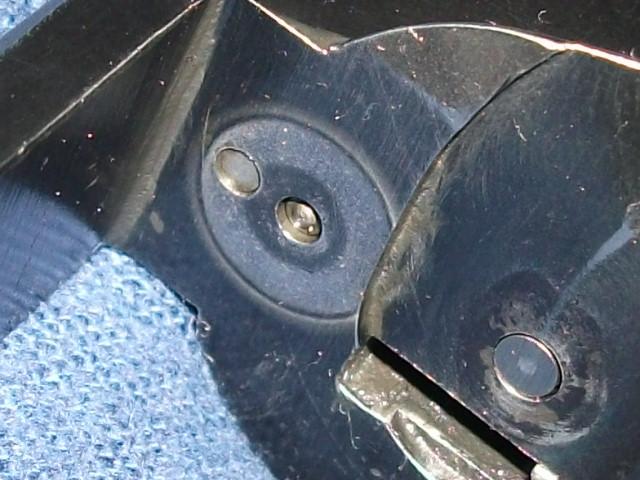-
Advisory Panel


A very enlightening reply, Peter! The professional version of what I have been doing up to now for old percussion revolvers - i.e. sliding a close fitting rod down the barrel and seeing if it reached the end of the chamber without snagging. If it does not touch the sides of the chamber, then the next refinement is to see if the cylinder can be revolved equal amounts clockwise and anticlockwise. Yes, it's a quick and dirty method, but suffices to distinguish between "hopeful" and "hopeless" cases.
-
The Following 2 Members Say Thank You to Patrick Chadwick For This Useful Post:
-
11-20-2012 06:04 PM
# ADS
Friends and Sponsors

-

Originally Posted by
Patrick Chadwick

I once read an article explaining very plausibly that a revolver needed a touch of end shake. If I remember clearly (and I hope this can be checked) the argument was on firing that the pawl will first push the cylinder as far forwards as it will go. The case will initially expand to grip the chamber walls, the primer will be pushed back, and then the cartridge base will be pushed back onto the recoil plate. Microseconds later the cylinder will be pushed back, thus shoving the case back into the chamber and recovering some end play so that the cylinder can rotate. If the cylinder has no end play whatsoever, then it cannot move back and the revolver will jam up pretty quickly as powder and lubricant residues get between the back end of the barrel and the front face of the cylinder. Thinking it through, this seems to imply that if the gap between cartridge base and recoil plate is X thousandths of an inch, then you need a similar amount of end play to make sure that the recoiling cylinder can press the cartridge back into the chamber again. It would explain why my
Swiss
1882 revolver, make with watch-like precision and just about zero end play, jams solid after one complete cycle of the cylinder - it is too precise - too closely fitted for the black powder load!
Not that I measure end shake on much of anything besides S&W revolvers, but on these the cylinder float can be controlled by adding "O" shaped shims between the end of the yoke ("crane" to Colt types) and the cylinder ID. I will often set it to 0.002" on general purpose Smiths and 0.001" on hunting and target S&Ws if everything else is running true. I run many of these revolvers fast and dirty. No dramas to date. My old 686 .357 has had multi tens of thousands of rounds through it. End shake is still tight, but that's about the only thing!
The usual binding drama on Smiths is when the cylinder drags against the rear face of the barrel, which the shims will cure straight away.
As for the Enfield revolver, it never occurred to me that the forward motion of the Enfield's cylinder would be controlled by anything other than cylinder axis' rear face (which shimming would change, if so.) or the front of the cylinder sleeve which is very "beefy". But I've never had a binding drama with one, nor headspace so excessive that misfires occurred. So it's been of no concern until now! Given the low pressure of the round, binding due to cartridge set-back seems highly unlikely.
-
Thank You to jmoore For This Useful Post:
-
Advisory Panel



Originally Posted by
jmoore

Given the low pressure of the round, binding due to cartridge set-back seems highly unlikely
Now I wish I'd bought that copy of Gun Digest when I had the chance. It made sense when I read it, now I'm not so sure. But if a revolver cartrdge is very lightly loaded, then surely the case will expand poorly and not grip the chamber wall (indicated by powder residue on the outside of the case) and thus the whole case could be shoved back while the bullet is moving forwards but has not yet left the chamber mouth. When the cylinder is pushed forwards on firing, the clearance between the back of the cylinder and the recoil plate must surely produce similar effects to those in a rifle with a large headspace???
-
-
Yes, but the case doesn't grip the chamber walls afterwards. It will be driven forward by the firing pin when the pressure falls.
Also note that the rearward motion of the case often partially recocks the hammer, so there's a secondary hit in many cases. Never noticed by the shooter!
( I have a Model 547 S&W that has a case driving pin above the firing pin. The impact of the 9mm case against this pin is sufficient to
drive the hammer to full cock! With the trigger stop i have on this revolver, it would sometimes be fired but the hammer would appear to have never fallen! Weird. But not hard to sort, so now it doesn't do that anymore.)

Breech face of the 547. Note the "case reseating pin" above the firing pin. Needed with the high pressure 9x19 tapered walled cartridge.
Note that if the firing pin hole is too big, there is a small chance that the primer may flow into the clearance enough to lock things up. But I'd guess it's a very remote possiblity with the .380/200 AKA .38 S&W.
BTW, I have some Gun Digests from that period. Any clue which one?
Last edited by jmoore; 11-21-2012 at 06:20 PM.
-















 PM
PM











